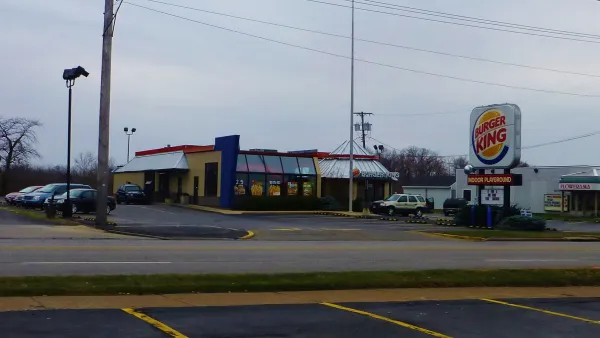Gina Kolata reports on the findings of two new studies that question the very concept of food deserts in poor neighborhoods, and the connection between fresh food access and obesity.
The idea that many poor urban neighborhoods lack access to fresh food (food desert), which contributes to childhood obesity rates in such areas, has become a common cause driving planning and policy makers across the country, including Michelle Obama's signature Let's Move campaign. As Kolata reports, two new studies have raised serious questions about the premise behind both ideas.
Helen Lee, of the Public Policy Institute of California, published a study in the March issue of Social Science and Medicine, questioning the common occurrence of food deserts in poor urban neighborhoods. "Poor neighborhoods, Dr. Lee found, had nearly twice as many fast food restaurants and convenience stores as wealthier ones, and they had more than three times as many corner stores per square mile. But they also had nearly twice as many supermarkets and large-scale grocers per square mile."
The other study mentioned in the article focused on the connection between fresh food access and childhood obesity rates. That study, authored by Roland Sturm of the RAND Corporation, and published in February in The American Journal of Preventive Medicine, "found no relationship between what type of food students said they ate, what they weighed, and the type of food within a mile and a half of their homes," writes Kolata.
Although "Some experts say these new findings raise questions about the effectiveness of efforts to combat the obesity epidemic simply by improving access to healthy foods," the goal of increasing access to fresh foods is just one of a host of efforts intended to combat America's obesity epidemic. Mrs. Obama's initiative, for example, also stresses improving food in schools, increasing physical education time, and educating people on the importance of healthy diets, as Kolata notes.
FULL STORY: Studies Question the Pairing of Food Deserts and Obesity

Analysis: Cybertruck Fatality Rate Far Exceeds That of Ford Pinto
The Tesla Cybertruck was recalled seven times last year.

National Parks Layoffs Will Cause Communities to Lose Billions
Thousands of essential park workers were laid off this week, just before the busy spring break season.

Retro-silient?: America’s First “Eco-burb,” The Woodlands Turns 50
A master-planned community north of Houston offers lessons on green infrastructure and resilient design, but falls short of its founder’s lofty affordability and walkability goals.

Test News Post 1
This is a summary

Analysis: Cybertruck Fatality Rate Far Exceeds That of Ford Pinto
The Tesla Cybertruck was recalled seven times last year.

Test News Headline 46
Test for the image on the front page.
Urban Design for Planners 1: Software Tools
This six-course series explores essential urban design concepts using open source software and equips planners with the tools they need to participate fully in the urban design process.
Planning for Universal Design
Learn the tools for implementing Universal Design in planning regulations.
EMC Planning Group, Inc.
Planetizen
Planetizen
Mpact (formerly Rail~Volution)
Great Falls Development Authority, Inc.
HUDs Office of Policy Development and Research
NYU Wagner Graduate School of Public Service


























